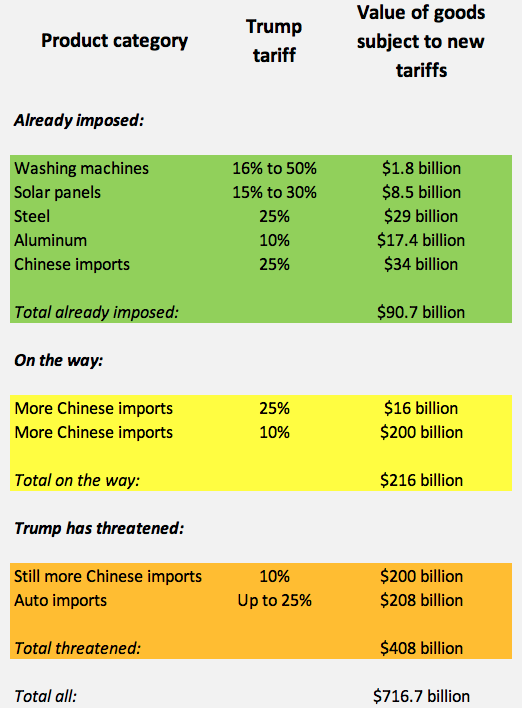This week in Trumponomics: The reckless trade war gets worse
You’re probably getting sick of hearing it. I’m getting sick of saying it. But week-by-week, President Trump is escalating his trade war and making business leaders gloomier about where it’s all headed.
The latest worrisome developments are an official effort by the Trump administration to identify an additional $200 billion worth of Chinese imports Trump can hit with a 10% tariff. As with other threatened tariffs, it’s a tossup whether Trump will actually impose the tariffs, or merely wield the threat of them as negotiating leverage. But so far, the tariff-happy Trump has imposed nearly all the trade protections that have gotten as far as an official review.
Yahoo Finance and many others acknowledge there are problems with trade, especially involving China. But escalating tariffs are the equivalent of a dumb bomb dropped close to our own front lines, with collateral damage inflicting many friendly casualties. For that reason, this week’s Trump-o-meter reads FAILING for the second week in a row. That’s our second-lowest grade.

Trump may feel emboldened by the stock market’s muted reaction to his escalating tariffs, which has fallen into a kind of panic-recover pattern: Stocks sell off when the news seems surprisingly bad, but then tend to bounce back as Wall Street analysts do the math and conclude that there won’t be too much damage, today. And the most harm, so far, seems to have fallen on small- and medium-sized US exporters, along with farmers, who aren’t really represented on the stock market.
[See how we grade the Trump economy so far.]
Yet the stock market is disappointingly flat this year, when it might otherwise be up on account of the Trump tax cuts that went into effect at the start of the year. Consumer sentiment dropped in the latest survey, due to “negative concerns about the impact of tariffs,” according to economist Richard Curtin of the University of Michigan. And Treasury Secretary Steven Mnuchin told Congress this week that trade talks with China have “broken down,” with no obvious path forward. Some strategy.
For those confused about where things stand, here’s the trade-war scorecard Yahoo Finance updates as (bad) news warrants, with the tariffs Trump has actually imposed in green, those he seems likely to impose in yellow and others he has merely suggested in orange:

China, Canada, and Europe have retaliated against Trump’s tariffs by putting their own tariffs on a like amount of US exports, which is beginning to cause the intended harm. Consumer-products giant Procter & Gamble (PG) said this week that virtually all of its products sold in Canada will be subject to a new 10% tariff that Canada imposed in response to Trump’s tariff on steel and aluminum imports. P&G can decide whether to eat the 10% tax and keep prices stable, or pass some or all of the price hike onto consumers. Trump is giving such exporters the Hobson’s choice of either accepting lower profitability or upping prices and losing market share.
We’ll know by the fall if Trump really plans to go ahead with the next tranche of tariffs on $200 billion worth of Chinese imports. If he does, China will almost certainly respond in kind, as it has done up till now. Trump may believe that he holds a, well, trump card, given China imports about $525 billion worth of goods and services to the United States, while US exports to China amount to just $190 billion or so. So there are far more Chinese imports to tax than there are American imports to China.
But China can retaliate in many ways other than tariffs, and besides, every tariff on imports to the United States raises costs and prices for Americans. So Trump’s tariffs punish Chinese exporters and American consumers alike.
There’s also the perverse incentive Trump is creating, by giving some U.S. producers more of an incentive to make stuff overseas, so they can sell it in foreign markets without the added cost of a tariff aimed at American-made stuff. It gets even more complicated than this when producers everywhere have to start rearranging their global supply lines to minimize the impact of tariffs and take more and more production outside the US-China axis.
And even then, China is exploiting the breach to make side deals with—oh, never mind. I’ll pick up the tirade next week, most likely.
Confidential tip line: [email protected]. Click here to get Rick’s stories by email.
Read more:
Rick Newman is the author of four books, including “Rebounders: How Winners Pivot from Setback to Success.” Follow him on Twitter: @rickjnewman
Follow Yahoo Finance on Facebook, Twitter, Instagram, and LinkedIn
